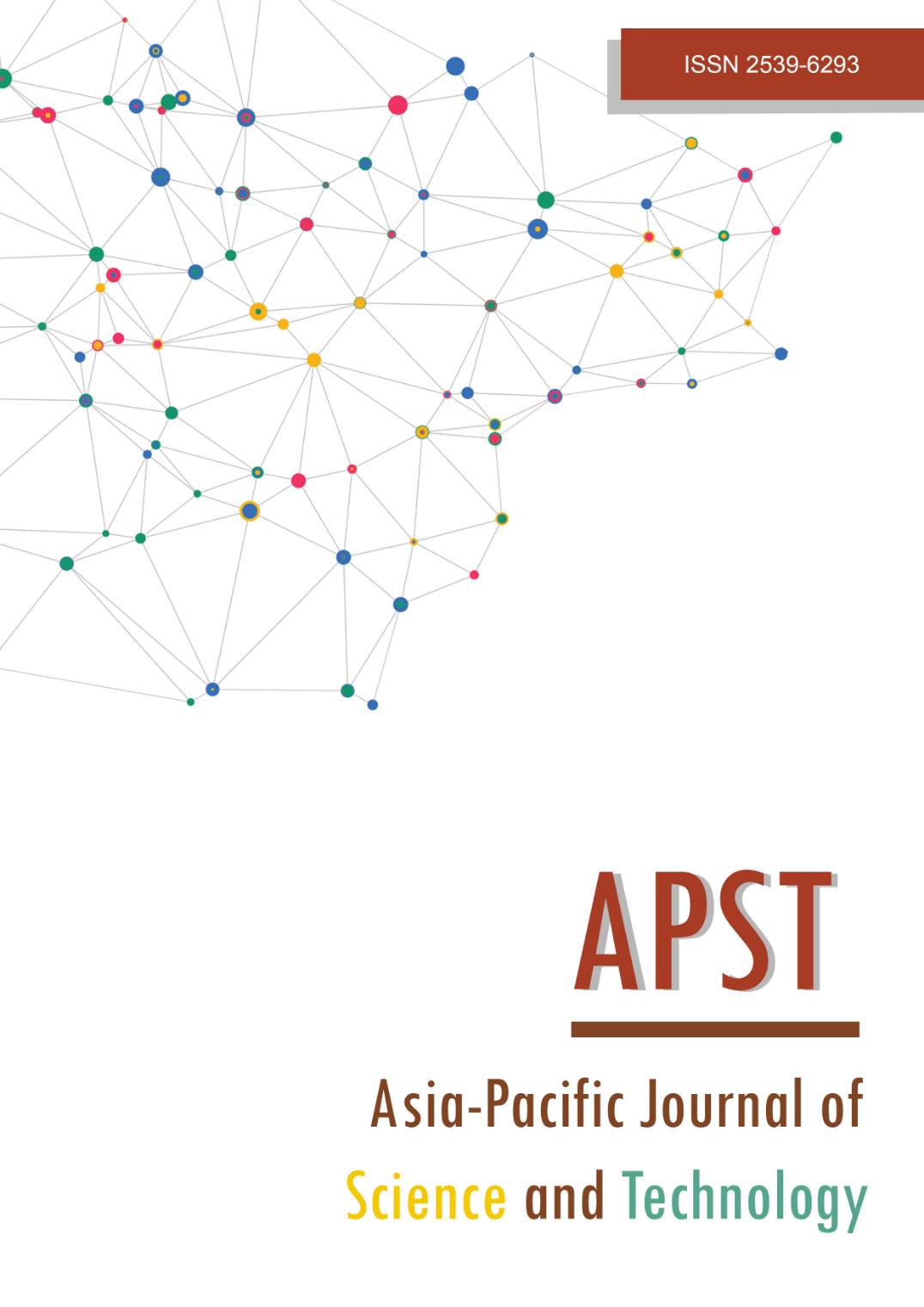Methane recovery from cassava starch wastewater via anaerobic digestion: Effect of inoculum source and kinetic study
Main Article Content
Abstract
The effects of inoculum sources on anaerobic digestion (AD) of cassava starch wastewater (CSW) were examined. Four different inoculums were used in this study, including the inoculum derived from anaerobically digested cassava starch wastewater (ADCS), pig manure (ADPM), cow manure (ADCM), and fresh elephant manure (EM). ADCS presented the highest methane potential of 351.04 NmL/g-volatile solid (VS)added. ADPM and ADCM derived from animal manures presented the lower methane potentials of 305.34 NmL/gVSadded and 329.95 NmL/ g-VSadded, respectively. EM showed the lowest methane potential of 239.43 NmL/gVSadded. Total chemical oxygen demand removal efficiencies showed the same trend with the methane potential and varied between 51.5% and 34.2%. The modified Gompertz equation well-fitted to the experimental data with R2 more than 0.99. The methane potential of ADCS was 343.41 NmL/ g-VSadded, which is not significantly different from the data obtained from the experiment. ADCS also presented the shortest lag phase of 3.75 days. Thus, ADCS could be the ideal inoculum for AD of CSW because of the good acclimation of the microorganisms to the substrate. However, when the availability of inoculum sources is concerned, the ADPM and ADCS could be the appropriate alternative inocula.
Article Details
References
[2] Papong S, Rotwiroon P, Chatchupong T, Malakul P. Life cycle energy and environmental assessment of bio-CNG utilization from cassava starch wastewater treatment plants in Thailand. Renew Energy. 2014;65:64-69.
[3] Tonrangklang P, Therdyothin A, Preechawuttipong I. Overview of biogas production potential from industry sector to produce compressed bio-methane gas in Thailand. Energy Procedia. 2017;138:919-924.
[4] Jiraprasertwong A, Maitriwong K, Chavadej S. Production of biogas from cassava wastewater using a three-stage upflow anaerobic sludge blanket (UASB) reactor. Renew Energy. 2019;130:191-205.
[5] Dhamodharan K, Kumar V, Kalamdhad AS. Effect of different livestock dungs as inoculum on food waste anaerobic digestion and its kinetics. Bioresour Technol. 2015;180:237-241.
[6] Vrieze J, Raport L, Willems B, Verbrugge S, Volcke E, Meers E, et al. Inoculum selection influences the biochemical methane potential of agro-industrial substrates. Microb Biotechnol. 2015;8(5):776-786.
[7] Orobio BP, Bravo AD, Sánchez JR, Molina KV, Lozada PT. Effect of inoculum on the anaerobic digestion of food waste accounting for the concentration of trace elements. Waste Manag. 2018;71:342-349.
[8] Rajbhandari BK, Annachhatre AP. Anaerobic ponds treatment of starch wastewater: case study in Thailand. Bioresour Technol. 2004;95(2):135-143.
[9] Lu X, Zhen G, Estrada AL, Chen M, Ni J, Hojo T, et al. Operation performance and granule characterization of upflow anaerobic sludge blanket (UASB) reactor treating wastewater with starch as the sole carbon source. Bioresour Technol. 2015;180:264-273.
[10] Colin X, Farinet JL, Rojas O, Alazard D. Anaerobic treatment of cassava starch extraction wastewater using a horizontal flow filter with bamboo as support. Bioresour Technol. 2007;98(8):1602-1607.
[11] SAI GLOBAL Standards Logistlation [Internet]. Chicago: The Company Limited;c2021 [2021 Jan 11]. VDI 4630. Fermentation of organic materials - Characterisation of the substrate, sampling, collection of material data, fermentation tests. VDI-Handbuch Energietechnik. 2004. Available from: https://inf ostore.saiglobal.com/en-us/Standards/VDI-4630-2016-1115305_SAIG_VDI_VDI_2590568/.
[12] Standardmethods.org [Internet]. Washington: The Association; c2018. [2021 Jan 11]. Availalble from: https://www.standardmethods.org/.
[13] Anderson GK, Yang G. Determination of bicarbonate and total volatile acid concentration in anaerobic digesters using a simple titration. Water Environ Res. 1992;64(1):53-59.
[14] Lay JJ, Li YY, Noike T. Effect of moisture content and of chemical fermentation nature on methane characteristics solid wastes. J Environ Syst Eng. 1996;1(552):101-108.
[15] Fettig J, Pick V, Haun UA, Blumberg M, Phuoc NV. Treatment of tapioca starch wastewater by a novel combination of physical and biological processes. Water Sci Technol. 2013;68(6):1264-1270.
[16] Ammary BY. Treatment of olive mill wastewater using an anaerobic sequencing batch reactor. Desalination. 2005;177(1-3):157-165.
[17] Pearse LF, Hettiaratchi JP. Effects of inoculum source on the biochemical methane potential (BMP) of the organic fraction of municipal solid waste in solid-phase BMP assays. In: Kirby O, editor. Canadian Society for Civil Engineering (CSCE) Annual Conference-Growing With Youth; 2019 June 12-15; Quebe, Canada. Quebec: Canada:2019. p.1-9.
[18] Sawatdeenarunat C, Surendra KC, Takara D, Oechsner H, Khanal SK. Anaerobic digestion of lignocellulosic biomass: challenges and opportunities. Bioresour Technol. 2015;178:178-186.
[19] Gu Y, Chen X, Liu Z, Zhou X, Zhang Y, Pellera FM, et al. Effect of inoculum sources on the anaerobic digestion of rice straw. Bioresour Technol. 2014;158(3):697-704.
[20] Araujo IR., Gomes SD, Tonello TU, Lucas SD, Mari AG, Vargas RJ. Methane production from cassava starch wastewater in packed-bed reactor and continuous flow. J Brazillian Assoc Agric Eng. 2018;38(2):270-276.
[21] Polo CM, Castro MC, Soria BY. Reviewing the anaerobic digestion of food waste: from waste generation and anaerobic process to its perspectives. Appl Sci. 2018;8(10):1-33.
[22] Khanal SK. Anaerobic biotechnology for bioenergy production: principles and applications. 1st ed. Iowa: John Wiley & Sons, Inc.; 2008.
[23] Amha YM, Anwar MZ, Brower A, Jacobsen CS, Stadler LB, Webster TM, et al. Inhibition of anaerobic digestion processes: applications of molecular tools. Bioresour Technol. 2018;247:999-1014.
[24] Racho P, Pongampornnara A. Enhanced biogas production from modified tapioca starch wastewater. Energy Reports. 2019;6:744-750.
[25] Ghatak MD, Mahanta P. Comparison of kinetic models for biogas production rate from saw dust. Int J Res Eng Technol. 2014;3(7):248-254.
[26] Pellera F, Gidarakos E, Gu Y, Chen X, Liu Z, Zhou X, et al. The effect of substrate/inoculum ratio on the kinetics of methane production in swine wastewater anaerobic digestion. Bioresour Technol. 2018;158(2014):697-704.
[27] Deepanraj B, Sivasubramanian V, Jayaraj S. Effect of substrate pretreatment on biogas production through anaerobic digestion of food waste. Int J Hydrogen Energy. 2017;42(42):26522-26528.
[28] Córdoba V, Fernández M, Santalla E. The effect of substrate/inoculum ratio on the kinetics of methane production in swine wastewater anaerobic digestion. Environ Sci Pollut Res. 2018;25(22):21308-21317.
[29] Kim MJ, Kim SH. Conditions of lag-phase reduction during anaerobic digestion of protein for high-efficiency biogas production. Biomass Bioenerg. 2020;143(2):105813.


